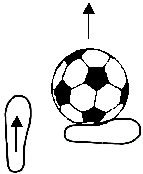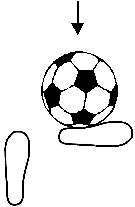Related topics: Overview Of How To Teach Inside-of-Foot Passing & Receiving, Diagnosing & Solving Problems With 2-Touch Passing With Inside-of-Foot, Diagnosing & Solving Problems With Inside-of-Foot Receiving, Detailed Directions For Teaching Inside-of-Foot Pass, Detailed Directions For Teaching How To Receive a Pass With Inside-of-Foot
See Dribble Around Cone & Pass Relay Race No Lines Drill.
Over 75% of all passes & receptions are made using the inside-of-the-foot. SoccerHelp believes passing, receiving and dribbling are the most fundamental and important skills to teach. To be a good player, a child must learn the correct technique for the inside-of-foot "push" pass, yet over 50% of youth players use incorrect technique. The result is passes that are inaccurate, don't have the right pace or don't stay on the ground. It's important to teach proper technique at an early age because if a child hasn't learned the proper technique by U-10, it's hard to correct the improper technique.
Teaching The Inside-of-
Foot "Push" Pass:

|
- Have the player face the target & "square up" so he, ball & the target are in a straight line.
- Place the "plant" foot about 4" from the side of the ball, pointing toward the target. (The direction the plant foot points is important because that is the direction the hips will face; try it). The plant foot can be toward the middle or back of the ball, whichever the player prefers.
- Head over ball, looking down; both knees slightly bent.
- Teach the proper motion by first having the player place his striking foot flat against the back of the ball (about 5" above the ground) and pushing the ball toward the target and following through toward the target. (A push & follow-through; not a jab. Think of a tennis serve. However, jabbing a 1-touch pass is okay).
- Be sure he contacts the ball with his toes pulled up (i.e., with the foot parallel to the ground) & the ankle locked. Make contact with the arch, below the anklebone & follow through toward the target so the ball has top spin.
- Then, have him do the same, except start one step back from the ball, so the player, the ball & the target are in a straight line. This step provides power to the pass. If the pass goes into the air it means it was struck too low.
|
Receiving A Pass Using
Inside-of-Foot:

|
- Receive the ball even with the toes of the plant foot (or a little in front).
- Stiffen or relax the receiving foot so the ball stops about one step away (so you can quickly take one step & strike it; it is this step that gives power to the pass).
- Be sure the receiving foot is 4" - 5" off the ground (if too low the ball will pop up) & contact the ball on the back part of foot (under the anklebone), not near the toes. Pull the toes up so the foot is parallel with the ground (not pointing downward). (If a player can't remember to raise his foot, have him practice by raising his foot higher than the ball & then bringing the foot down in front of the ball to stop it. This will help him to remember).
- If you want the ball to go to the left or right (instead of straight in front) you must angle your foot & contact the ball more in front or behind, depending on whether you want it to go left or right.
|

